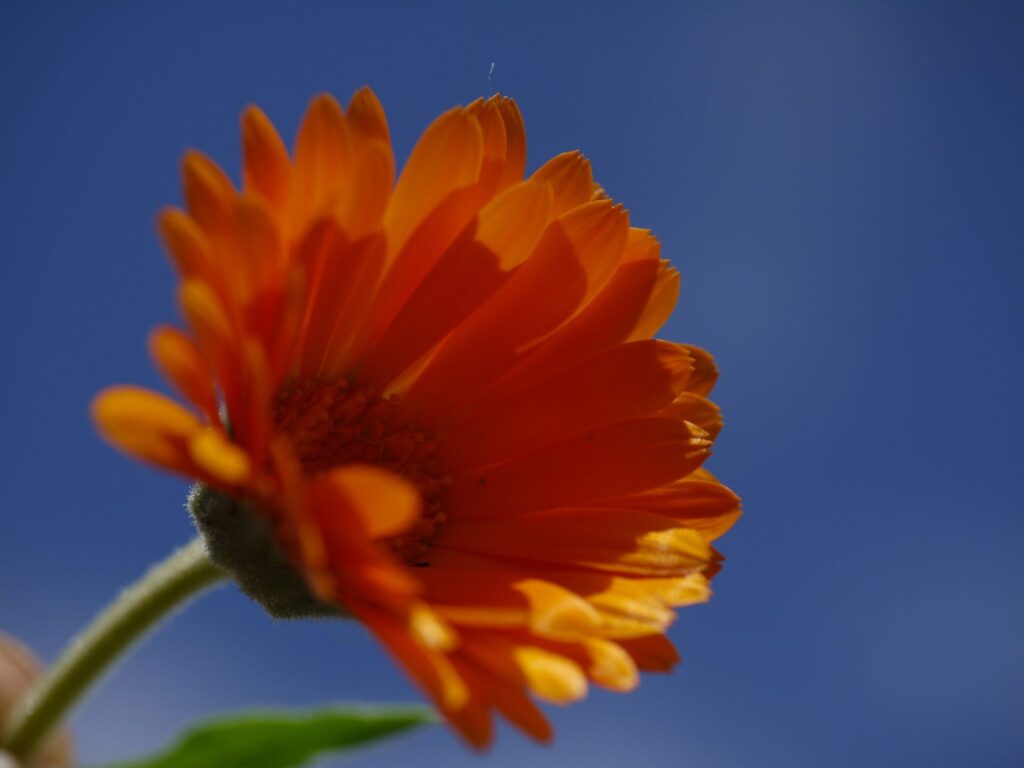Le souci des jardins
Calendula officinalis L.
Compositae
Marigold is an annual plant originating from the Mediterranean basin, widely cultivated both as an ornamental plant and as a medicinal plant. In France, we have garden marigold, Calendula officinalis L., which can only be found cultivated, and fields marigold, Calendula arvensis L., which grows spontaneously in fields, wastelands and lawns, mainly in the South of the country. Calendula arvensis L. qui pousse spontanément dans les champs, les friches et les pelouses, essentiellement dans le sud du pays.
Its Latin name, Calendula comes from the Latin word Calende, which means the first day of the month, as marigold can flower at every beginning of the month. Its flowering period can be quite extended and last throughout the whole year if the conditions are favorable.
What seems at first to be a flower is actually an inflorescence, a set of flowers, called flower head. This inflorescence is composed of central tubular flowers (the “heart”) and ligulated peripheral flowers (the “petals”). Ligulate flowers are used to add color and spice to dishes, especially with rice, which has earned them the name of bastard saffron. They have a slightly peppery taste.
Marigold’s medicinal use can be traced from long ago: the plant appears in the capitulary De Villis, a manuscript dating from the end of the 8th century or beginning of the 9th century which recommends the cultivation of a number of vegetable or medicinal species in the Royal gardens.
In this text, Marigold is mentionned under the name of solsequia, “which follows the sun”, because its flowers follow sunlight just like sunflowers (sunflower is an American species that was introduced in Europe only in the XVIth century).
Hildegarde de Bingen, important religious figure and herbalist from the 11th century, mentions the virtues of marigold for skin care in a recipe that seems far from our current habits: “a man whose head is” squamous “will detach the soft part of bacon, He will also remove the rind, throw the whole, and keep the hard part, which he will carefully crush in a mortar; He will smear his head and the scales will fall and his head will become beautiful again.”
Marigold is today widely used in natural cosmetics for its softening, healing, anti-inflammatory properties.
In the garden, marigold is cultivated easily and reseeds abundantly thanks to its three different types of seeds. The central seeds are achenes which are curled on themselves and fall at the foot of the plant, others carry hooks which allow them to cling to animals and the third kind of seeds, in the periphery, are spread out and shaped like a sail that allows them to be carried away by the wind.
These dissemination methods are called accordingly barochory, zoochory and anemochory
Calendula balm
Fill a jar of marigold flowers up to the top without packing them too much.
Pour olive oil until covering the plants and leave for three weeks.
Filter with a coffee filter.
In a bowl, pour 30 ml of this oil and add 5 grams of beeswax.
Heat in a water bath until the wax is melted, stir with a fork, then pour into a pot.
This can be used for the whole family except for those who are allergic to marigold or beeswax.
It can be used throughout the year.
